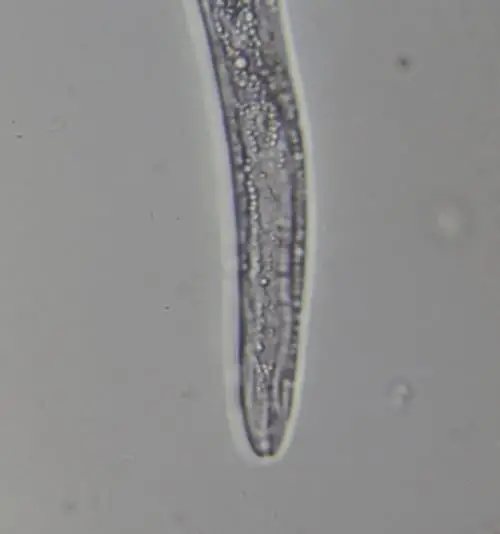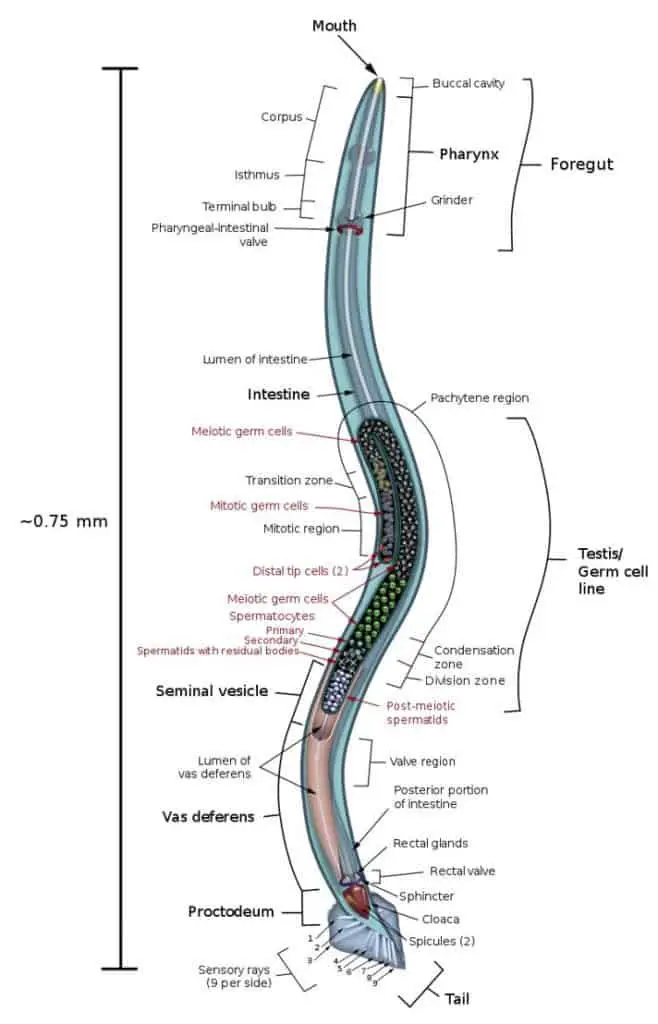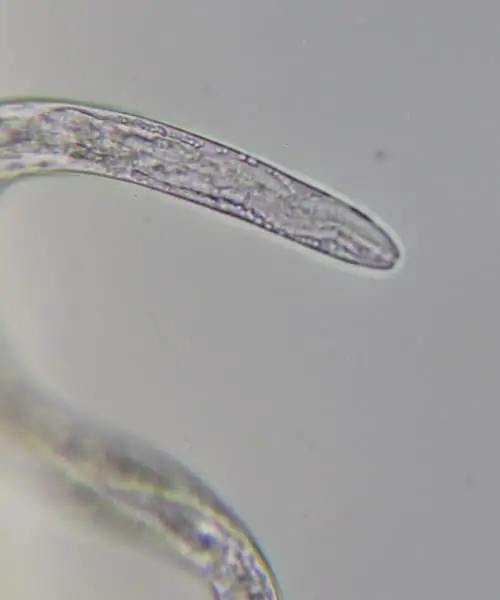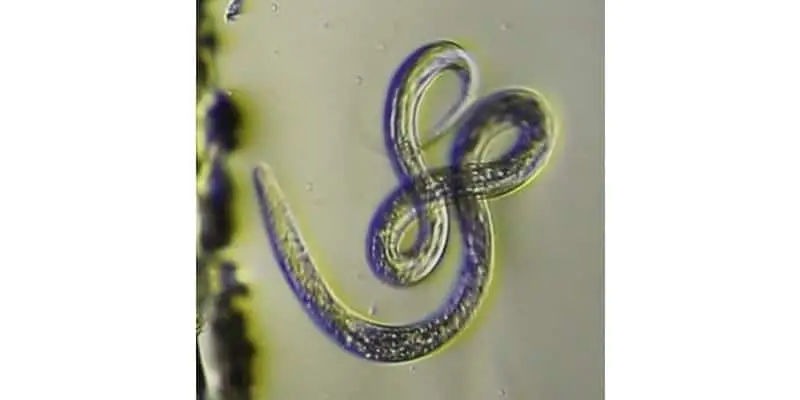The world as viewed from a microscope reveals an environment filled with an enormous number of microorganisms. Many of these microorganisms date back to the beginning of life on earth and have been foundational in the world as we see it today. Amongst this ancient world are roundworms known as nematodes.
Nematodes are a diverse group of worms that make up the phylum Nematoda. Otherwise known as roundworms, nematodes live as either free-living organisms in terrestrial and aquatic organisms or as parasites in plants and animals. Defining characteristics include a round, elongated, invertebrate body and measure anywhere from 0.1 millimeters to over 3 feet in some parasitic nematodes.
How are Nematodes Classified?

The kingdom and phylum nematodes are detailed below:
- Kingdom: Animalia – Animalia consists of multicellular eukaryotic organisms. Most use organic matter as an energy source, breathe oxygen, are mobile, and reproduce sexually.
- Phylum: Nematoda – Like many other animals, Nematoda are triploblastic and have an embryonic mesoderm that is squished in between an ectoderm and endoderm. They possess a fluid-filled cavity that lays within the external body wall that surrounds internal organs called a pseudocoelom.
Five clades of the phylum Nematoda are also described below. A clade, in this case, is a monophyletic group of descendants from a common Nematoda ancestor:
- Clade: ParaHoxozoa – Contains nearly all the major animal groups, including the Placozoa and Cnidaria.
- Clade: Bilateria – Animals with bilateral symmetry, meaning the left and right sides are identical to each other.
- Clade: Nephrozoa – Containing over a million extinct species, the Nephrozoa include protostomes and deuterostomes.
- Clade: Protosome – This clade is characterized by animals that form at the organism’s mouth before its anus during embryonic development.
- Clade: Nematodia – This grouping includes roundworms and horsehair worms.
Some other well-known classifications of Nematoda are listed below:
- Order: Monhysterida – This basal order consists of a marine worm that is either spiral or circular. They are funnel-shaped and lightly cuticularized; oftentimes, having protrusible teeth.
- Order: Dorylaimida – The most diverse order of nematodes with a smooth cuticle This order can be found in mainly marine and terrestrial soil environments.
- Order: Rhabditida – An order of free-living, zooparasitic, and phytoparasitic microvorous nematodes that live strictly within the soil.
- Order: Trichocephalida – Strictly parasitic nematodes that have wreaked havoc on poultry in Japan and Indonesia.
- Order: Mermithida – Worms that are mostly endoparasites and arthropods known for their narrowness.
- Class: Enoplea – An ancestral divergence with many fossil remains of the nematode that are distinguished by their bottle-shaped esophagus, pocket-like amphids, and simple excretory system.
- Class: Secernentea – The more modern divergence with fewer fossil remains of the nematode, these are exclusively terrestrial nematodes that are generally parasitic to both plants and animals.
Given their age and abundance, it should come as no surprise that nematodes are ancestral to so many living creatures. Their ability to tolerate many different environments has resulted in many different evolutions of the nematode.
What is the Structure of Nematodes?

It’s true that there are many different species of nematodes. They are nearly the most abundant organism on planet earth. With that being said, their anatomy is strikingly similar from species to species, making them hard to identify individually.
The smallest nematodes range from 5 micrometers in thickness to 100 micrometers. They can grow from 0.1 millimeters all the way up to 2.5 millimeters. The smallest species are microscopic, whereas the larger free-living species can reach up to 3 feet in length.
The body is oftentimes ridged with rings and other key features. The head is oftentimes uniquely flared. The body of the nematode is bilaterally symmetrical with sensory hairs. The mouth of the roundworm has either three or six lips with rows of teeth along the edges. The epidermis is covered with a thick collagen multilayered cuticle.
Just below the epidermis is the muscle. The cuticle works alongside the muscle to create a hydro skeleton. Uncommon to other animals, projections run through the muscle to the nerve cords, which is abnormal as nerve cells extend fibers to the muscles instead of the other way around.
The mouth of the nematode may also have a stylet, which is a sharp projectile common in invertebrates for capturing prey. Digestive glands begin at the pharynx, which produces digestive enzymes that aid in the breaking down of nutrients. Nematodes do not have stomachs, rather just an intestine that runs the length of the body.
This muscle-less gut helps absorb nutrients as they are broken down by enzymes. Since there are no muscles in the intestines, digestion depends entirely on the movement of the nematode. The sphincter of the nematode helps regulate the movement of food throughout the body.
Waste is excreted as ammonia through the pores of the nematode. Salt is also excreted from the body of the nematode to aid with osmoregulation. The nervous system of the nematode has sensory cilia. Bodies of nematodes are lined with small hair-like bristles that provide the sense of touch. There are four nerves that run the length of the body in total. The dorsal nerve controls movement. The lateral nerve is strictly sensory. The ventral nerve is the biggest and does both.
Free-Living Nematodes
Free-living nematodes make up approximately half of all living nematode species. They consume algae, bacteria, fungi, and dead organisms.
Caenorhabditis elegans are the most studied terrestrial nematode. They are one of the most studied organisms as far as learning and behavior go thanks to the relative simplicity of the organism. Their entire nervous system of over 302 neurons has been intricately mapped and its entire genome has been sequenced.
Free-living marine nematodes can be found on kelp or within the soils. It’s estimated that 90% of marine soils contain nematodes. They are found on the ocean floor as well as continental shelves. Some species can even withstand thermal waters. Marine species similarly feed on the decomposing matter in the soils and sometimes each other.
Parasitic Nematodes
Parasitism is a form of symbiotic relationship in which the parasite invades a host to sustain itself which ultimately causes the host harm. There are many well-known and well-studied species of parasitic nematodes.
Ascaris Nematode
Ascaris are transmitted to humans by soil and live within the intestines. It’s estimated that over 1.2 billion people in the world are infected with ascaris, many not even knowing it. Most hosts do not experience any symptoms, although symptoms can include stomach discomfort or pain.
This parasite accounts for a majority of intestinal parasitic infections in the world, although modern day sanitary practices mean that this parasite is almost nonexistent in the United States. It’s common where sanitary sewer systems are unavailable or where human feces are used as fertilizer.
Eggs of ascaris are transmitted via feces into the soil by an infected individual. If someone else contacts the affected soil, the eggs can be transmitted. This can happen when the hands or fingers touch the mouth after farming, eating fertilized fruits or vegetables, etc.
Severe infections of ascaris can lead to intestinal blockages. Other severe symptoms include a cough as the ascaris work their way through the body. In rare cases, it can stunt the growth of children. It is easily treatable by medication and is rarely fatal.
Enterobius Nematode
This parasite is commonly referred to as the human pinworm thanks to the female’s long and pointy tail. It is also commonly referred to as a seatworm or a threadworm. An infection by enterobius is known as enterobiasis, also known as pinworm infection.
Similar to the ascaris, enterobius enters its host as an egg most commonly through feces. This can be through the soil, poor hygienic practices, and more. Eggs can survive in the intestines for up to three weeks before finally hatching. This is the most common type of parasitic infection in the developed world.
Those at risk include school children with poor hygienic routines, health care institutions such as nursing homes, and prisons. School-aged children are the most common hosts of enterobius. It’s estimated that up to 20% of school-aged children will develop enterobiasis at some point.
Symptoms include an itchy anus, which is how the eggs are commonly spread. When a host itches their anus, they oftentimes touch other objects and transfer the eggs of the parasite. Excessive itchiness can also make it difficult for the host to sleep. Many infected individuals will not show symptoms at all.
Itching, particularly at night, is caused by the female enterobius as it enters the anus to lay its eggs. Both the migrating female as well as the eggs themselves can cause discomfort. Sensations can range from a classic itch to a tickling or crawling sensation, and rarely acute pain.
Pinworms do not cause any harm to human tissue and also do not migrate through any tissues. In females, pinworms may migrate into the external orifice of the uterus and up to the fallopian tubes, causing inflammation and irritation of the vagina. This can lead to vaginal discharges and an itchy vulva.
Pinworms can also migrate into the urethra while carrying feces. Feces and other bacteria can cause an infection that leads to a urinary tract infection. One study demonstrated that up to 36% of young girls that had a urinary tract infection also had enterobiasis. This can lead to painful urination.
Treatment of infection is possible. Medications are oftentimes taken in two doses, two weeks apart from one another. Everyone who lives with or is in frequent contact with an infected individual should also be treated at the same time. Washing the hands, clothing items, and frequently changing undergarments is recommended. There is research that demonstrates enterobiasis may lead to appendicitis, although there is an overall lack of evidence to prove this and is controversial in the medical community. This parasite has been documented throughout much of human history. Animals are not known to spread the parasite.
Whipworm Nematode
The Trichuris trichiura is identified by its whip-like shape. Like the other parasitic nematodes, the whipworm’s life cycle begins as its eggs are transferred via feces in soil or other objects. It takes approximately three weeks for the whipworm to become infectious. When it reaches the large intestine, it causes a disease called trichuriasis.
Trichuriasis, or whipworm infection, is mostly found in warmer climates. It is mostly a tropical disease in Asia, Africa, and South America. Infection in the United States is rare. Eggs are incubated for two to three weeks in ideally warm and moist conditions, which is why it is considered a tropical parasite.
Infection is associated with poor hygiene, contaminated foods, and shaded soils. It can happen when fingers or food have contaminated dirt on them and are not properly washed and then eaten. Fruits and vegetables in tropical areas should be thoroughly washed, peeled, and cooked to prevent infection.
The eggs start in the small intestine. Once hatched, the larva makes its way to the large intestine. The large intestine is where the adult whipworm wreaks havoc. Symptoms can range from nothing to death.
If only a couple of eggs are ingested and ultimately hatched, then there may not be any symptoms for the host. Individuals infected with many worms oftentimes experience abdominal pain, lethargy, and diarrhea. Diarrhea may contain blood. Infection in children can stunt growth and stunt intellectual development. Red blood cell count may also plummet.
Parasitic coinfection has been shown to transmit HIV/AIDs, tuberculosis, and malaria. Sub-Saharan Africa is particularly at risk. Extreme cases can lead to gastrointestinal bleeding that can lead to death. Treatment is readily available. It consists of a three-day medication. Reinfection is common and medication must be taken again. There are studies to develop a vaccine, although one does not yet exist.
Potato Cyst Nematodes
These nematodes are uniquely parasitic to plants, particularly within the roots of potatoes and tomatoes. They stunt the growth of potato and tomato plants leading to lower yields. High populations of potato cyst nematodes can result in loss of yield up to 60%.
These nematodes can create large-scale devastation if left unchecked. Potato farming is a billion-dollar industry and a 60% decrease in yield can be detrimental economically. Countries that are largescale producers of potatoes that are at risk include Australia, the United States, China, and India.
Potato Cyst Nematodes are particularly pesky because they persist year after year. To prevent the spread of potato cyst nematodes, farmers are encouraged to frequently clean equipment before changing locations. Some farmlands must be certified as potato cyst nematode-free before they can sell their seed. Pesticides may be used but are not effective in eliminating the nematodes, only in reducing their population. The best way to prevent infection is to use partially resistant potato varieties. Studies also show that crop rotation every six years can keep the population in check.
How do Nematodes Reproduce?

The huge variety of phylum Nematodes leads to a variety of different methods of reproduction. Thankfully, there are many features that are prevalent in all species. All nematodes reproduce sexually.
Male nematodes are typically smaller in size than females. Their reproductive structures include one testis, although two are found in some species. Sperm is produced in the testis and stored until use. Copulatory spicules aid in dilating the vulva of the female nematode and deliver the sperm. Spicules are made up of hardened cuticles.
Female nematodes include one or two ovaries, receptacles, uteri, ovijector, and a vulva. The ovary produces oocytes. The receptacles store the spermatozoa until ready to be fertilized. Once the oocyte is fertilized, it is stored within the uterus. The muscular ovijector utilizes the movement of the nematode’s body to expel the egg through the vagina.
All species of nematodes lay eggs. Cross-fertilization is most common in nematodes. Eggs may be either embryonated or not when passed through the vagina. This means that it is possible for the fertilized egg to not have yet developed. Eggs are protected by an outer shell. The eggs hatch into larvae that are nearly identical to adult nematodes.
Hermaphroditism may also occur in rare circumstances with certain species. In this situation, the gonads produce and store sperm first until the eggs are produced. Hermaphroditism is most common in environments with a low food supply. Parthenogenesis is also possible in rare cases. Parthenogenesis occurs when a male copulates with a female, but the sperm does not fuse with the egg. The contact is enough to get the ovum to divide. Since no fusion takes place, the male does not contribute any genetic material and the offspring are identical clones of the mother.
What do Nematodes Eat?
Nematodes eat a variety of microorganisms consisting of bacteria, protozoans, and fungi. Larger nematodes feed on over 100 families of inspects, plants, and even other nematodes.
For larger prey nematodes will eat by extracting the internal body parts. They do this by scratching away at the exterior of the organism until it punctures structure. For smaller organisms like bacteria or protozoa the nematode simply swallows its prey whole.
Can Nematodes Benefit a Garden?
Yes, Nematodes are vital to soil health as secondary decomposers. When they eat, they excrete nutrients that are crucial to plant health, soil structure, and water holding capacity. Terrestrial nematodes are used by farmers as an indicator of soil health since they only live in aerobic conditions and do not live within extreme soils. These nematodes play an incredibly important role in the decomposition process. They can be found most in muds and transport in water films in between soil particles.
Some parasitic nematodes have been considered an area of interest for their pest control ability for certain common garden insects. The Steinernema and Heterorhabditis nematode groups are most effective against caterpillars, webworms, cutworms, and other borers. The effectiveness of these parasitic nematodes rests highly on environmental factors. They require moist humid environments and are susceptible to drying which will result in death. Also, temperature is an important factor. In environments of high heat (90 to 95 degrees F) can result in death for most parasitic nematodes. On the other end of the spectrum lower temperatures (below 55 degrees F) can cause the nematode to become inactive.
The History of Nematodes
Nematodes are thought to be one of the oldest forms of life on earth. Believed to have been evolved from primordial ooze, nematodes are thought to date back around one billion years. The oldest known nematodes were discovered preserved in near perfect condition in amber that dates back some 400 million years.
This means that nematodes are one of the oldest forms of life on the planet, coming even before bacteria, protozoa, and fungi. Since then, different species of nematodes have been discovered in fossils, frozen in the arctic ice, and in the bodies of Egyptian mummies.
Over the years, nematodes have evolved into over 14,000 known species. It’s believed that there are millions of species not yet identified. Species of nematodes are extremely difficult to differentiate from each other, but as technology advances more and more species are discovered.
Ancient Egyptian records depict humans fighting off parasitic nematodes by ingesting goat feces or even removing them surgically. The Old Testament of the Bible speaks of ‘fiery serpents among the people’ that caused death amongst the Israelis. Shakespeare described seed-galls in wheat plants caused by nematodes in 1549.
It wasn’t until 1758 that Carl Linnaeus, the Swedish botanist who is credited with formalizing binomial nomenclature, first described the nematode genera, and introduced them into the scientific community. The group Nematoda was introduced by a German scientist named Karl Rudolphi in an 1808 publication that studied parasitic worms.
Since Rudolphi’s study, parasitic nematodes seem to get the most attention from the scientific community even though most nematodes are nonparasitic. So much so that there is an entire scientific discipline called nematology that is dedicated to studying nematodes. Dr. Johannes Govertus de Man, a biologist from Zealand is known as the father of nematology. The study focuses mainly on agricultural practices to control parasitic nematodes. As nematology progressed, researchers began to understand that nematodes are an important secondary decomposer, and many are beneficial to the soil.
Takeaways
Nematodes are simple organisms but that does not mean they are not interesting. They are organisms that offer a whole field of study and inquiry as well as practical applications to your won garden. Nematodes vary widely in size and some even require a microscope to observe. If you thought nematodes were something out of science fiction or folklore you’re wrong, they are very real and very interesting so go out get a specimen and fire up your microscope!
References
- https://nematology.ucr.edu/about/what-are-nematodes
- https://www.sunburstabs.com/the-history-of-nematodes-and-their-impact-on-agriculture/
- https://today.oregonstate.edu/archives/2011/apr/research-outlines-mysterious-evolution-nematodes-%E2%80%93-one-earth%E2%80%99s-first-animals#:~:text=%22The%20oldest%20known%20nematodes%20are,after%20bacteria%2C%20protozoa%20and%20fungi.
- https://ucmp.berkeley.edu/history/linnaeus.html
- https://courses.lumenlearning.com/wm-biology2/chapter/phylum-nematoda/
- https://pubmed.ncbi.nlm.nih.gov/31811424/
- http://nemaplex.ucdavis.edu/Taxadata/Mermiida.htm
- https://www.encyclopedia.com/environment/encyclopedias-almanacs-transcripts-and-maps/secernentea-secernenteans
- https://www.sciencedirect.com/topics/agricultural-and-biological-sciences/free-living-nematodes#:~:text=Free%2Dliving%20nematodes%20feed%20on,in%20soil%20and%20marine%20environments.
- https://www.sciencedirect.com/topics/biochemistry-genetics-and-molecular-biology/caenorhabditis-elegans
- https://www.sciencedirect.com/science/article/pii/B9780123948076000617
- https://www.cdc.gov/parasites/ascariasis/index.html
- https://www.wur.nl/en/Research-Results/Chair-groups/Plant-Sciences/Laboratory-of-Nematology/About-us/History-of-Nematology.htm#:~:text=Parasitic%20nematodes%20were%20already%20known,to%20live%20under%20human%20skin.&text=A%20handful%20of%20dirt%20contains%20at%20least%2050%20different%20species%20of%20nematodes.
- https://nematode.unl.edu/reproduc.htm#:~:text=All%20nematodes%20lay%20eggs.,of%20reproduction%20in%20some%20nematodes.

